Toyota RAV4 (XA50) 2019-2025 Owners Manual: Intuitive parking assist
The distance from your vehicle to objects, such as a wall, when parallel parking or maneuvering into a garage is measured by the sensors and communicated via the multi-information display or Multimedia Display and a buzzer. Always check the surrounding area when using this system.
System components
Ôľá Location and types of sensors
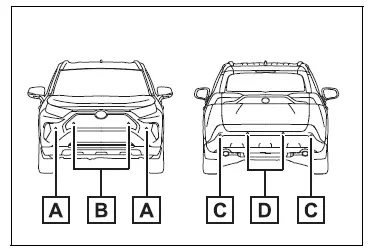
- Front corner sensors
- Front center sensors
- Rear corner sensors
- Rear center sensors
Ôľá Display (Multi-information display)
When the sensors detect an object, such as a wall, a graphic is shown on the multi-information display depending on the position and distance to the object.
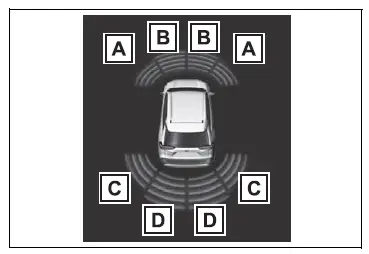
- Front corner sensor detection
- Front center sensor detection* 1
- Rear corner sensor detection* 2
- Rear center sensor detection* 2
*1:Displayed when the shift lever is
in a driving position
*2:Displayed when the shift lever is
in R
Ôľá Display (Multimedia Display)
When the sensors detect an object, such as a wall, a graphic is shown on the Multimedia Display depending on the position and distance to the object.
- When the Toyota parking assist monitor (if equipped) is displayed
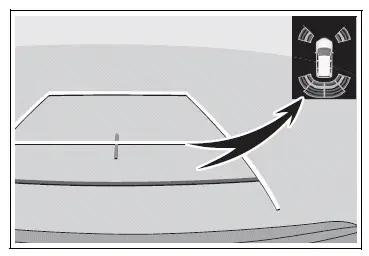
A simplified image is displayed on the upper corner of the screen when an obstacle is detected.
- When the panoramic view monitor (if equipped) is displayed
Panoramic view
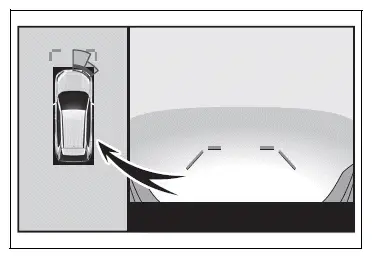
A graphic is shown when the panoramic view monitor is displayed.
Except panoramic view
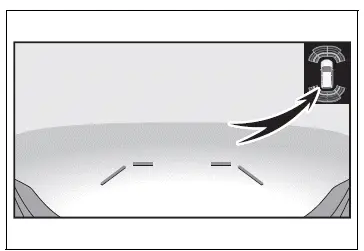
A simplified image is displayed on the upper corner of the screen when an obstacle is detected.
Turning intuitive parking assist on/off
The Intuitive parking assist can
be enabled/disabled on the 
screen of the multi-information
display.
When the intuitive parking assist function is disabled, the intuitive parking assist OFF indicator illuminates on the multi-information display.
To re-enable the system, select 
on the multi-information display,
select  and turn it on.
and turn it on.
If the system is disabled, it will remain off even if the engine switch is turned to ON after the engine switch has been turned off.
WARNING
ÔľáCautions regarding the use of the system
There is a limit to the degree of recognition accuracy and control performance that this system can provide, do not overly rely on this system. The driver is always responsible for paying attention to the vehicle's surroundings and driving safely.
ÔľáTo ensure the system can operate properly
Observe the following precautions.
Failing to do so may result in the vehicle being unable to be driven safely and possibly cause an accident.
- Do not damage the sensors, and always keep them clean.
- Do not attach a sticker or install an electronic component, such as a backlit license plate (especially fluorescent type), fog lights, fender pole or wireless antenna near a radar sensor.
- Do not subject the surrounding area of the sensor to a strong impact. If subjected to an impact, have the vehicle inspected by your Toyota dealer. If the front or rear bumper needs to be removed/installed or replaced, contact your Toyota dealer.
- Do not modify, disassemble or paint the sensors.
- Do not attach a license plate cover.
- Keep your tires properly inflated.
ÔľáWhen to disable the function
In the following situations, disable the function as it may operate even though there is no possibility of a collision.
- Failing to observe the warnings above.
- A non-genuine Toyota suspension (lowered suspension, etc.) is installed.
ÔľáNotes when washing the vehicle
Do not apply intensive bursts of water or steam to the sensor area.
Doing so may result in the sensor malfunctioning.
- When using a high pressure washer to wash the vehicle, do not spray the sensors directly, as doing so may cause a sensor to malfunction.
- When using steam to clean the vehicle, do not direct steam too close to the sensors as doing so may cause a sensor to malfunction.
ÔľáThe system can be operated when
- The engine switch is in ON.
- Intuitive parking assist function is on.
- The vehicle speed is less than about 6 mph (10 km/h).
- The shift lever is in a position other than P.
ÔľáIf "Parking Assist Unavailable Clean Parking Assist Sensor" is displayed on the multi-information display
A sensor may be covered with ice, snow, dirt, etc. Remove the ice, snow, dirt, etc., from the sensor to return the system to normal.
Also, due to ice forming on a sensor at low temperatures, a warning message may be displayed or the sensor may not be able to detect an object. Once the ice melts, the system will return to normal.
If a warning message is displayed even if the sensor is clean, there may be a sensor malfunction. Have the vehicle inspected by your Toyota dealer.
ÔľáIf "Parking Assist Unavailable" is displayed on the multi-information display
Water may be continuously flowing over the sensor surface, such as in a heavy rain. When the system determines that it is normal, the system will return to normal.
ÔľáSensor detection information
- The sensor's detection areas are limited to the areas around the vehicle's front and rear bumpers.
- The following situations may occur
during use.
- Depending on the shape of the object and other factors, the detection distance may shorten, or detection may be impossible.
- Detection may be impossible if static objects draw too close to the sensor.
- There will be a short delay between static object detection and display (warning buzzer sounds). Even at low speeds, there is a possibility that the object will come within 11.9 in. (30 cm) before the display is shown and the warning buzzer sounds.
- It might be difficult to hear the buzzer due to the volume of the audio system or air flow noise of the air conditioning system.
- It may be difficult to hear the sound of this system due to the buzzers of other systems.
ÔľáObjects which the system may not properly detect
The shape of the object may prevent the sensor from detecting it.
Pay particular attention to the following objects:
- Wires, fences, ropes, etc.
- Cotton, snow and other materials that absorb sound waves
- Sharply-angled objects
- Low objects
- Tall objects with upper sections projecting outwards in the direction of your vehicle
People may not be detected if they are wearing certain types of clothing.
ÔľáSituations in which the system may not operate properly
Certain vehicle conditions and the surrounding environment may affect the ability of a sensor to correctly detect objects. Particular instances where this may occur are listed below.
- There is dirt, snow or ice on a sensor.
(Cleaning the sensors will resolve this problem.)
- A sensor is frozen. (Thawing the area will resolve this problem.) In especially cold weather, if a sensor is frozen the sensor display may be displayed abnormally, or objects, such as a wall, may not be detected.
- When a sensor or the area around a sensor is extremely hot or cold.
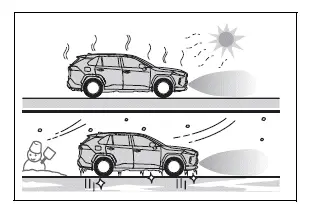
- On an extremely bumpy road, on an incline, on gravel, or on grass.
- When vehicle horns, vehicle detectors, motorcycle engines, air brakes of large vehicles, the clearance sonar of other vehicles or other devices which produce ultrasonic waves are near the vehicle.
- A sensor is coated with a sheet of spray or heavy rain.
- If objects draw too close to the sensor.
- When a pedestrian is wearing clothing that does not reflect ultrasonic waves (ex. skirts with gathers or frills).
- When objects that are not perpendicular to the ground, not perpendicular to the vehicle traveling direction, uneven, or waving are in the detection range.
- Strong wind is blowing.
- When driving in inclement weather such as fog, snow or a sandstorm.
- When an object that cannot be detected is between the vehicle and a detected object.
- If an object such as a vehicle, motorcycle, bicycle or pedestrian cuts in front of the vehicle or runs out from the side of the vehicle.
- If the orientation of a sensor has been changed due to a collision or other impact.
- When equipment that may obstruct a sensor is installed, such as a towing eyelet, bumper protector (an additional trim strip, etc.), bicycle carrier, or snow plow.
- If the front of the vehicle is raised or lowered due to the carried load.
- If the vehicle cannot be driven in a stable manner, such as when the vehicle has been in an accident or is malfunctioning.
- When tire chains, a compact spare tire or an emergency tire puncture repair kit are used.
ÔľáSituations in which the system may operate even if there is no possibility of a collision
In some situations, such as the following, the system may operate even though there is no possibility of a collision.
- When driving on a narrow road.
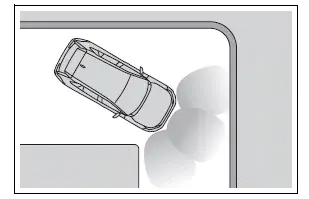
- When driving toward a banner, flag, low-hanging branch or boom barrier (such as those used at railroad crossings, toll gates and parking lots).
- When there is a rut or hole in the surface of the road.
- When driving on a metal cover (grating), such as those used for drainage ditches.
- When driving up or down a steep slope.
- If a sensor is hit by a large amount of water, such as when driving on a flooded road.
- There is dirt, snow, water drops or ice on a sensor. (Cleaning the sensors will resolve this problem.)
- A sensor is coated with a sheet of spray or heavy rain.
- When driving in inclement weather such as fog, snow or a sandstorm.
- When strong winds are blowing.
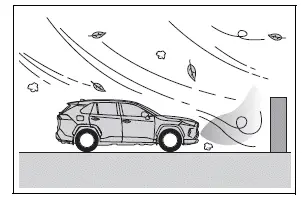
- When vehicle horns, vehicle detectors, motorcycle engines, air brakes of large vehicles, the clearance sonar of other vehicles or other devices which produce ultrasonic waves are near the vehicle.
- If the front of the vehicle is raised or lowered due to the carried load.
- If the orientation of a sensor has been changed due to a collision or other impact.
- The vehicle is approaching a tall or curved curb.
- Driving close to columns (H-shaped steel beams, etc.) in multistory parking garages, construction sites, etc.
- If the vehicle cannot be driven in a stable manner, such as when the vehicle has been in an accident or is malfunctioning.
- On an extremely bumpy road, on an incline, on gravel, or on grass.
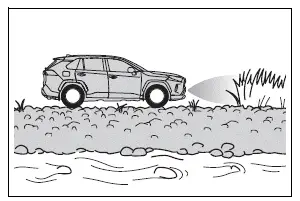
- When tire chains, a compact spare tire or an emergency tire puncture repair kit are used.
ÔľáCertification (Canada only)
This ISM device complies with Canadian ICES-001.
 Blind Spot Monitor operation
Blind Spot Monitor operation
Ôľá Objects that can be detected while driving
The Blind Spot Monitor uses rear side radar sensors to detect the
following vehicles traveling in adjacent lanes and advises the driver
of the presence o ...
 Sensor detection display,
object distance
Sensor detection display,
object distance
Ôľá Detection range of the sensors
Approximately 3.3 ft. (100
cm)
Approximately 4.9 ft. (150
cm)
Approximately 2.1 ft. (63 cm)
The diagram shows the detection
range of the sensors. Note that t ...
Other materials:
Installation (2006/01- )
Install abs and traction actuator assembly with bracket
Notice:
do not remove the hole plug before connecting the
brake tube. new actuators are filled with brake fluid.
Install the actuator with bracket with the 3 nuts.
Torque: 19 n*m (194 kgf*cm, 14 ft.*Lbf)
Hint:
The nuts should b ...
Srs airbags
The srs airbags inflate when the vehicle is subjected to certain
types of severe impacts that may cause significant injury to the
occupants. They work together with the seat belts to help reduce
the risk of death or serious injury.
Srs front airbags
Srs driver airbag/front passenger airb ...
Connecting a bluetooth®
device
Up to 5 bluetooth® devices (phones (hfp) and audio players
(avp)) can be registered.
If more than 1 bluetooth® device has been registered, select
which device to connect to.
Press the ÔÇťsetupÔÇŁ button.
Select ÔÇťbluetooth*ÔÇŁ.
*: Bluetooth is a registered trademark of bluetooth sig ...
